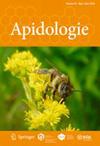Modeling the effects of stress and premature hive exiting behavior on honey bee (Apis mellifera) colony survival
Abstract
Honey bees have a complex social structure, with many factors affecting colony survival. Mathematical models are therefore valuable for understanding how individual variables affect honey bee colony dynamics. Previous honey bee population models have shown that accelerated aging due to stress can lead to colony decline. Our previous work showed that general developmental stress causes a previously undocumented behavior whereby very young workers exit the colony before they can fly, leading them to die prematurely on the ground outside the hive. In this study, we modeled the effects of this premature hive exiting behavior on colony survival. We used parameters from previous studies to inform our model and incorporated empirical data regarding the rate of premature hive exiting behavior driven by various developmental stressors. An equation to link premature exit with accelerated aging was also introduced to mirror population dynamics across different worker age groups. We found that higher rates of premature hive exiting behavior can accelerate colony collapse. A feeding variable (provisioning colonies with extra sugar syrup) and a brood break variable (preventing the queen from laying eggs for a given time period to decrease Varroa mite levels) were added to the model to examine ways to counteract the negative effects of premature hive exiting behavior and to assess their effectiveness at regulating the progression of worker aging. Our results suggest that both supplemental feeding and implementing brood breaks can bring a colony back from the brink of collapse.

 求助内容:
求助内容: 应助结果提醒方式:
应助结果提醒方式:


